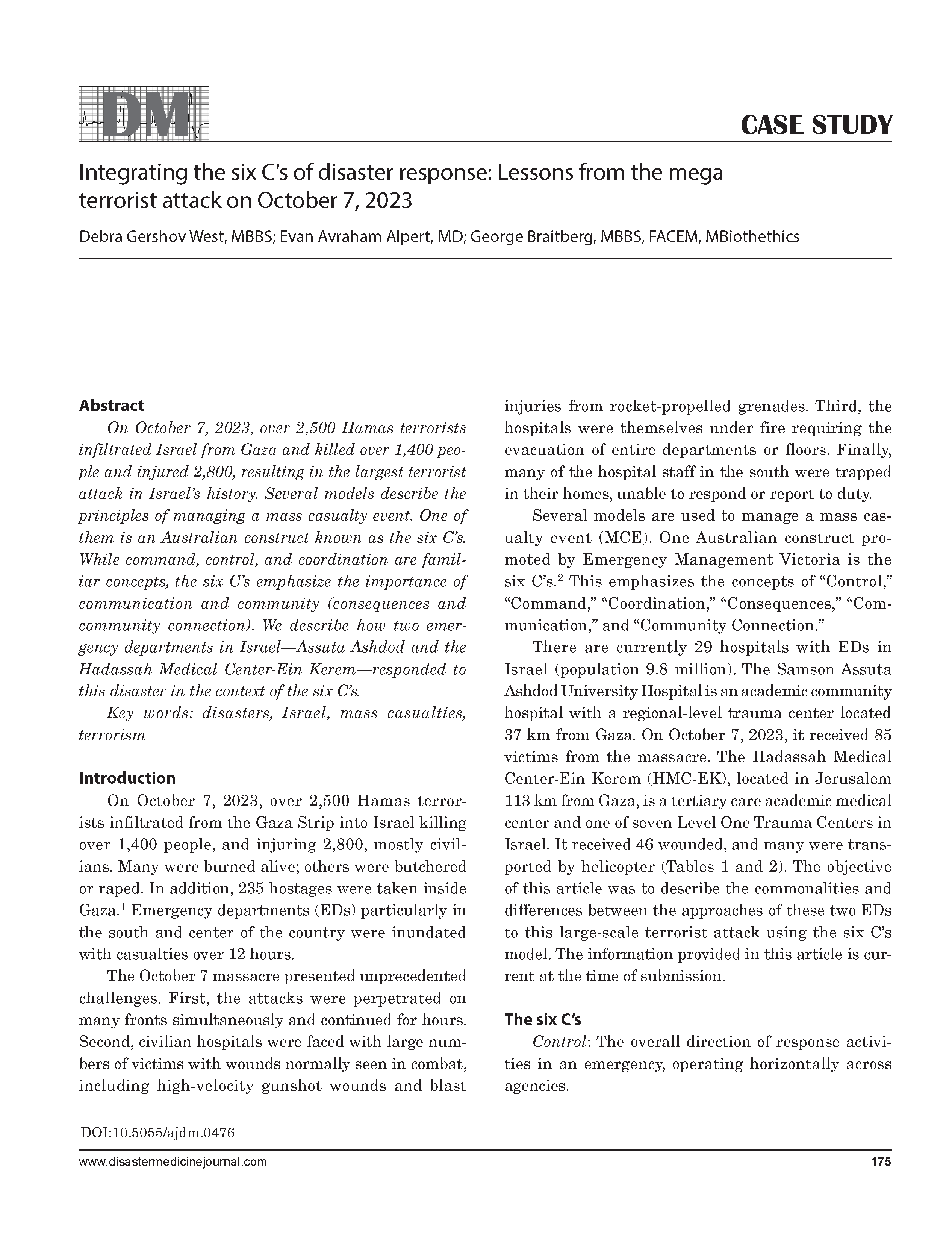Integrating the six C’s of disaster response: Lessons from the mega terrorist attack on October 7, 2023
DOI:
https://doi.org/10.5055/ajdm.0476Keywords:
disasters, Israel, mass casualties, terrorismAbstract
On October 7, 2023, over 2,500 Hamas terrorists infiltrated Israel from Gaza and killed over 1,400 people and injured 2,800, resulting in the largest terrorist attack in Israel’s history. Several models describe the principles of managing a mass casualty event. One of them is an Australian construct known as the six C’s. While command, control, and coordination are familiar concepts, the six C’s emphasize the importance of communication and community (consequences and community connection). We describe how two emergency departments in Israel—Assuta Ashdod and the Hadassah Medical Center-Ein Kerem—responded to this disaster in the context of the six C’s.
References
The New York Times: Hamas leaves trail of terror in Israel. Available at https://www.nytimes.com/2023/10/10/world/middleeast/israel-gazawar-hamas-deaths-killings.html. Accessed November 1, 2023.
Emergency Management Victoria: The 6 C’s. Available at https://www.emv.vic.gov.au/about-us/what-we-do/the-six-cs. Accessed November 1, 2023.
Ellis DY, Sorene E: Magen David Adom—The EMS in Israel. Resuscitation. 2008; 76(1): 5-10. DOI: 10.1016/j.resuscitation.2007.07.014.
Guinzburg A, Epstein D, Cohen J, et al.: Emergency care provided by the Israeli military airborne combat evacuation unit during helicopter winch rescue operations. Prehosp Emerg Care. 2021; 25(3): 397-403. DOI: 10.1080/10903127.2020.1757180.
Satterthwaite PS, Atkinson CJ: Using ‘reverse triage’ to create hospital surge capacity: Royal Darwin hospital’s response to the Ashmore reef disaster. Emerg Med J. 2012; 29(2): 160-162. DOI: 10.1136/emj.2010.098087.
Morton MJ, DeAugustinis ML, Velasquez CA, et al.: Developments in surge research priorities: A systematic review of the literature following the Academic Emergency Medicine Consensus Conference, 2007-2015. Acad Emerg Med. 2015; 22(11): 1235-1252. DOI: 10.1111/acem.12815.
Iizuka A, Aldrich DP: Attracting altruists: Explaining volunteer turnout during natural hazard events in Japan. Disasters. 2022; 46(2): 526-544. DOI: 10.1111/disa.12477.
Adini B, Peleg K, Cohen R, et al.: A national system for disseminating information on victims during mass casualty incidents. Disasters. 2010; 34(2): 542-551. DOI: 10.1111/j.1467-7717.2009.01142.x.
Beaton R, Stergachis A, Oberle M, et al.: The sarin gas attacks on the Tokyo subway—10 years later/lessons learned. Traumatology. 2005; 11(2): 103-119. DOI: 10.1177/153476560501100205.

Published
How to Cite
Issue
Section
License
Copyright 2007-2025, Weston Medical Publishing, LLC and American Journal of Disaster Medicine. All Rights Reserved.

